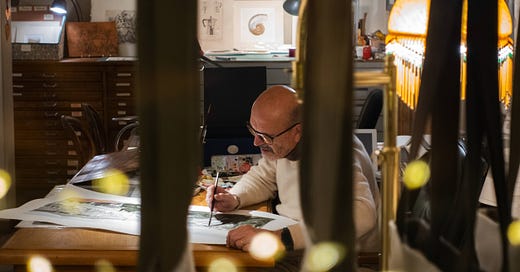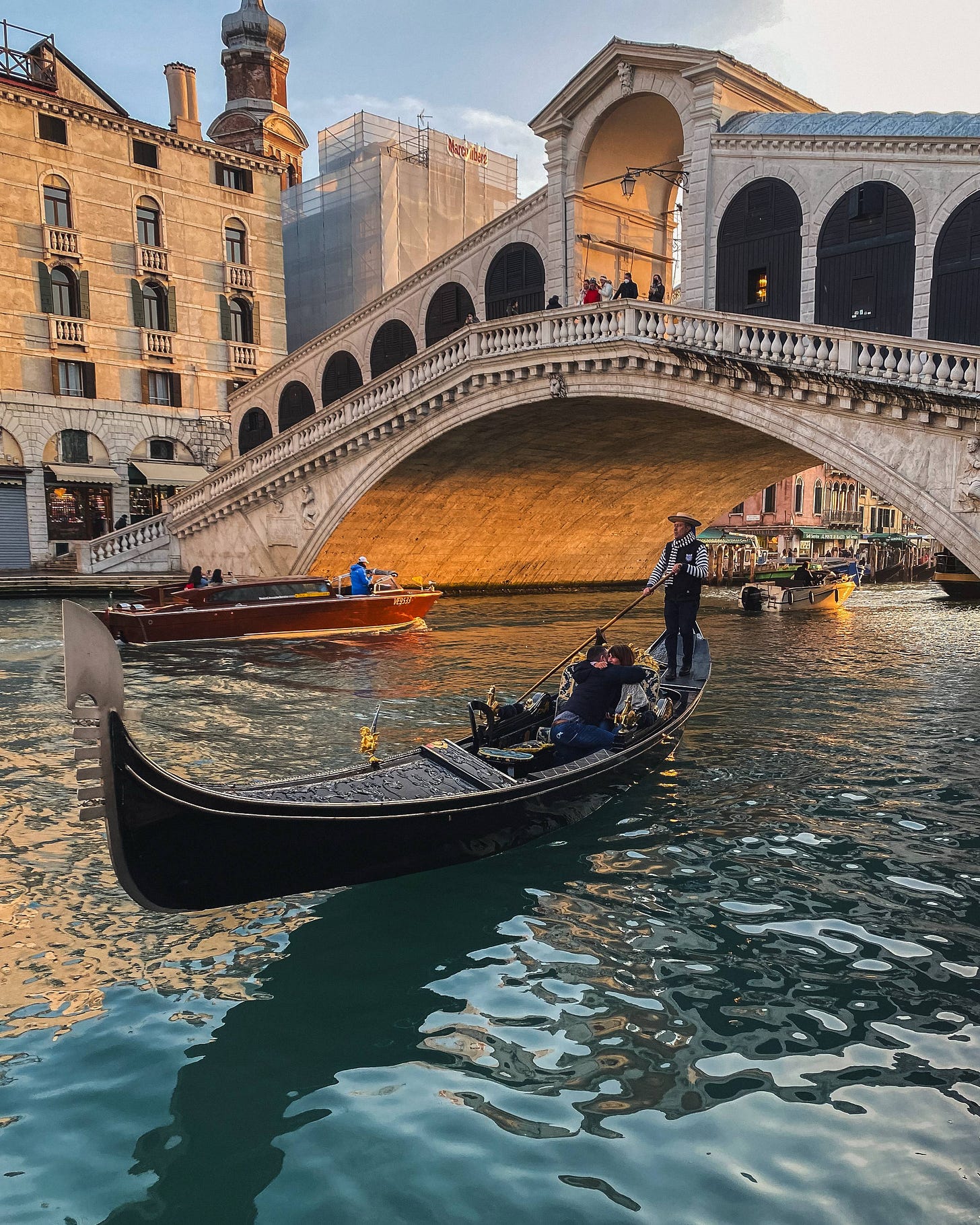It was a December evening in Florence. Puddles collected on the cobblestone paths underfoot while reflecting the string lights overhead. It was cold and damp, but there was a permeating warmth that blankets Europe in the winter. Those handful of weeks between Thanksgiving and Christmas are a special time in that part of the world, when the crowds have left and the locals have absconded into the snug pubs and wine bars.
We were out walking the streets, looking for one of those windows where ringing a bell will send an arm through a small hole in the wall offering a glass of wine. A plague-era invention from the 1600s, as I understand it. On our walk, we passed by a shop that seemed to sell a mix of art, antiques, and some other curiosities. The storefront looked closed, but I could see the glow of a dim light. As I kept walking, I passed by the window, and inside was a man sitting at a desk, paintbrush in hand, working on his art.
It was a simple and otherwise ordinary scene, but to me it was a familiar one. As someone who does much of my work alone, I appreciate the quiet work; words typed in solitude and images made in isolation. The unseen work. The work that nobody will know or even care about because, more often than not, it doesn't result in anything spectacular. But you do it because you have no other choice, the soul wouldn't allow it.
That's what the scene meant to me, so I raised my camera and pressed the shutter.
Recently, I posted this image on Substack Notes, thinking that the moment would resonate with other artists. And while it did, the image also prompted an interesting reaction from one:
I was surprised! Not because of a critique, but because it forced a different perspective. So I thought, maybe they’re kind of right?
It called to mind a conversation that photographers have debated for a while now - what are the ethics of photography? Especially pertaining to street photography when documenting people and scenes happens, more often than not, without consent. Work from folks like Bruce Gilden or Walker Evans are often examples.
Many have weighed in on this over the years, but perhaps none more incisively than Susan Sontag in On Photography, where she writes:
To photograph people is to violate them, by seeing them as they never see themselves, by having knowledge of them that they can never have; it turns people into objects that can be symbolically possessed.
Her stance is a provocative one. She wasn’t necessarily a photographer, so her distance from the medium gave her the ability to look at it critically. Sontag levies many criticisms on photography throughout the book, but a common thread is the power imbalance between the photographer and the subject, and an inherent violence in the act itself. Sontag strikes a harsh tone, but it’s one worth engaging with.
When I passed by that studio window, I didn’t knock or wave or try to catch the painter’s attention. I stayed outside, behind glass, and made the photo in silence. At the time it felt reverent, as though I was witnessing something private but beautiful, and preserving it without disruption. But was I preserving a moment or taking it for myself?
A few years ago, I was in Venice, meandering and finding my way through all the little nooks and crannies of the city. After enough twists and turns, I ended up at a corner near the Grand Canal, looking out onto the Ponte di Rialto bridge. The sun was setting and there was beautiful light draping over the bridge, so I pulled out my phone for a few pictures.
While composing and framing the image, I noticed a gondola passing beneath the bridge. It was the perfect subject for the moment, if not a little cliché. Though I didn’t realize until after a few snaps, there was a couple in the gondola, and the man was proposing to his girlfriend mid-picture. Steph was also standing next to me and accidentally got the entire moment on video.
When we realized what we had captured, we frantically shouted across to them as the gondola doubled back across the Grand Canal. They looked up at us, a little confused at first, but quickly realized what was going on. They shouted their phone number back to us so we could share the photos on WhatsApp. Unfortunately, in the flurry I misheard and jotted the number down wrong because I couldn’t find them on WhatsApp later that night.
A day or so later, I posted about this event to Instagram, asking the internet gods and sleuths out there to connect us with these strangers. Against all odds, it worked, and later that night we shared some photos and videos with them.
Anyway, the point is that nobody even questioned these photos as invasive at all. But why? It’s hardly different than me stopping to take a picture of the man at his desk. Is love inherently celebratory but a man painting in solitude feels private? The fact that they got engaged was coincidental and almost irrelevant. They were going to be the subject of the photo anyway, the proposal just amplified the meaning. So does the beauty of that moment or the happy outcome end up justifying my intrusion on their private moment?
I’d like to say that it always comes down to intent, and I think it mostly does. But the image doesn’t carry intention, it’s a recording of light. The image outlives the moment. It becomes its own thing, untethered from context and how I felt when I pressed the shutter. This friction is implicit in every image: what the photographer felt, what the subject lived, and what the viewer sees. Maybe that’s what makes photography so compelling and dangerous. It’s worth continuously interrogating our position as photographers or anyone with a smartphone for that matter.
If there is a violence in photography, it’s mirrored by a humanity in observation - in finding those quiet moments now often obscured by pixelated blue light. Maybe my image was intrusive, though I’d like to think the man in Florence would have understood, that if he looked up we would’ve shared a nod. But I’ll never know.







Interesting stuff Skylar. As a guy who spent nearly 20 years of his life creating privacy training for big global companies, I have to say … I think this whole fascination with privacy is overblown. We are all just dust in the wind, and if some stranger captures an image of us that happens to make some kind of sense to some other stranger, how on earth could it possibly cause any harm or any offense? We make too much of ourselves, not to say our data, when in fact we are insignificant beyond belief.
Quite a topic for discussion, and quite controversial as there are so many ways to look at it. Both photos in the post are like still-lifes. The man at his desk, the lighting, his attention to his work. The couple in the gondola, the bridge, the sky, lovely and romantic.Truly, I wonder if there is an answer.